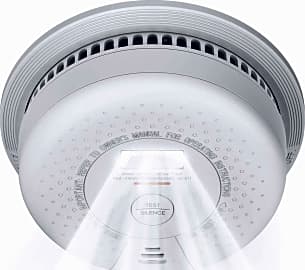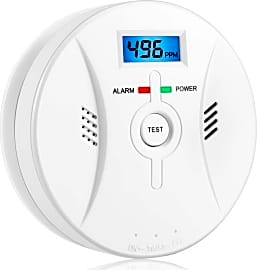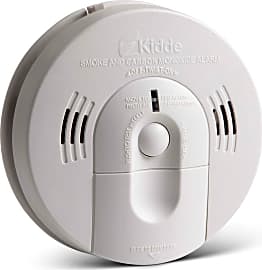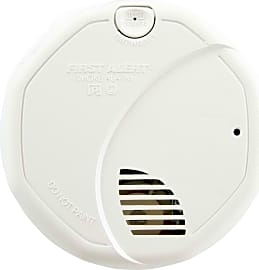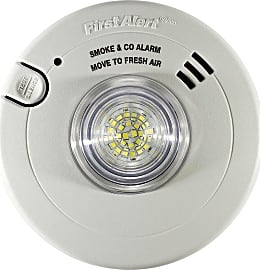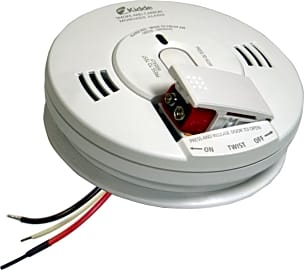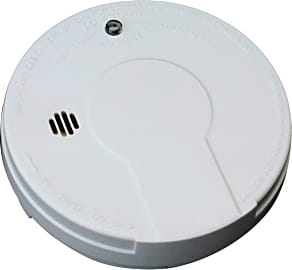The 10 Best Smoke Alarms

This wiki has been updated 41 times since it was first published in May of 2015. Nothing is more important than your family, and nothing is more expensive than your home. Protect them both with these smoke alarms. Our selections include both battery-powered and hardwired models, as well as options with convenient features, like integrated nightlights, voice alerts, and carbon monoxide detectors. Some top-of-the-line offerings can even connect with your home's smart system. When users buy our independently chosen editorial choices, we may earn commissions to help fund the Wiki.
Editor's Notes
January 28, 2021:
Unsurprisingly, it was a fairly steady round of updates in a very stable category. Our only real substantive changes this time around were removing the CooWoo Battery Powered, which seemed to be suffering from some availability issues, and replacing it with another solid, battery-powered option: the X-Sense SC07 — an affordably priced combination unit with a backlit LCD to keep you advised of ambient carbon monoxide levels.
We also considered adding the Roost PP3 to our list – a smart, nine-volt battery that affords any basic detector the luxury of app connectivity and remote control – but widespread user complaints of software updates rendering the device useless led us to decide against it. By the sounds of things, going forward, the company will only be offering cloud connectivity for their second-generation offering, which was only available direct from the company at the time of this update’s publication.
January 01, 2020:
The majority of existing choices for this category managed to make it through this round of updates. However, we did decide that the First Alert BRK 7010B was bit too pricey to stay, and we removed the Leeo Smart Alert – since the company stopped offering support for the model.
We also added several new selections to these rankings, including the First Alert BRK 7030BSL, a combination detector that incorporates a strobe light into its design, for the benefit of the hearing impaired; the X-Sense Escape Light, which immediately activates an LED emergency light during alarm states; and the First Alert Onelink Safe & Sound, an option with a built-in smart speaker that’s compatible with Apple HomeKit and Amazon Alexa.
A few considerations worth making while you shop:
Photoelectric vs. Ionization: The two basic types of sensors smoke alarms depend on are photoelectric sensors and ionization sensors. Dual-sensor options (which incorporate both types of sensor) are also widely available. While ionization sensors, like the one in the Kidde i9050, do a better job at detecting smoke from larger fires, photoelectric sensors, like the one in the Kidde KN-COPE-I, tend to be superior when it comes to detecting smoke from smoldering fires. Photoelectric sensors seem to be the most popular these days, probably because they’re less susceptible to false alarms via shower steam or burning food.
A note on dual-sensor models:
While dual-sensor models, like the First Alert BRK 3120B, might offer you better peace of mind than a single-sensor alternative, they still have their own problems. Internally, these sensors need to either be wired in series or parallel. If they’re wired in series, both sensors will need to detect smoke before the unit enters an alarm state – which means less false alarms, but a longer response time. Contrastingly, if the sensors are wired in parallel, only one sensor needs to detect smoke for the unit to enter an alarm state – which might mean a shorter response time, but certainly means more false alarms.
Battery-Powered vs. Hardwired: Although I still believe that there’s a place in the world for battery-powered smoke alarms – for instance, in a camper, gazebo or carport – for the most part, hardwired is the way you want to go, if at all possible. Besides reducing the frequency of battery swaps (they do still have backup batteries that will need to be changed every few years, or in some cases are just rated to last the recommended life of the smoke alarm), the biggest benefit of hardwired alarms is the fact they can be connected throughout your home. In this manner, smoke detected in your basement will activate alarms on the second floor of your home, giving you and your family a chance to get to safety before the smoke makes it all the way up to your sleeping quarters.
It’s also worth mentioning that many modern building codes demand hardwired smoke detectors be installed in new homes – and often several of them. So, if you are still considering a battery-powered option, do your due diligence and make sure that you’re not accidentally allowing a building code infraction that could potentially affect your insurance coverage.
Versatility: Smoke alarms are important, but so are carbon-monoxide alarms, and with so many excellent combination options on the market – like the battery-powered Viwon GS811-A and the hardwired First Alert BRK 7030BSL – why not kill two birds with one stone?
Advanced options like the Nest Protect 2nd Generation and First Alert Onelink Safe & Sound are designed to connect with your home’s smart system, and offer further opportunities for versatility through additional features like built-in night lights and speakers.
Special Honors
Roost Smart Battery – 2nd Generation This nifty device presents a simple way to convert any basic, battery-powered detector to a capable smart unit, issuing alerts to your smartphone any time an alarm is activated. You can even use it to silence false alarms remotely, and it has a five-year battery life. getroost.com
Two Ways To See The Smoke
That increase in light hitting the sensor sets off the alarm.
The image you're looking at is a rough peek at the layout inside of an ionization smoke detector. These, along with photoelectric smoke detectors are your best bets for detecting a fire in your home, but each one has its advantage over the other.
In the ionizing smoke detector, you're installing a small radioactive device in your home. But don't worry; your pregnant cat isn't about to give birth to a three headed kitten who speaks Spanish. It's not that kind of radiation.
Within the housing of an ionizing smoke detector is a small amount of Americium-241, a radioactive isotope that emits alpha particles throughout a plastic chamber.
The good news here as far as your safety goes is that alpha particles are pretty weak, too weak, in fact, to penetrate the plastic of the chamber, and weaker still when exposed to a large area. You'd have to break open the chamber and rub the Americuim-241 all over your eyeballs to get a negative effect.
Anyway, as the material decays its alpha particles ionize the oxygen and nitrogen in the air, the resulting positively charged atoms and negatively charged electrons of which are drawn to two leads in the compartment, each of which is charged either negatively or positively.
That creates a nice little current. When smoke, or steam, or excessive heat enters the chamber, it interferes with the ionization process, reducing the current, which sets off the alarm. That makes ionization smoke detectors ideal for detecting flash fires, kitchen fires, and any other fire that produces a lot of heat, without necessarily producing a lot of smoke.
Photoelectric sensors, on the other hand, require no radioactive materials. While that doesn't make a real difference in their safety considering the relative safety of Americium-241, it does mean that they don't require any special disposal the way ionizers do.
Instead of relying on ionization, photoelectric smoke detectors use LEDs to send a beam of light across the top of a T-shaped tube. At the bottom of the T is a photo cell that detects the base amount of light leaking down the stem of the T.
When smoke enters that chamber, its particles reflect a lot more light down the stem and onto the photo cell. That increase in light hitting the sensor sets off the alarm.
A design like this makes a photoelectric smoke detector ideal for picking up slow smoldering fires like the ones started by cigarettes or the one burning inside you whenever you think of your in-laws.
Fire In The Hole!
So, you know how each of the two types of smoke alarms works, but that might not yet have cleared up the burning question: which kind should you buy?
I'll make it easy for you. You actually need both.
I'm not saying that you absolutely have to have both kinds of smoke detectors at every detection point in your home, although that would be the safest way to set them up.
Since ionization smoke detectors are best suited for picking up big, flashy fires, the kitchen seems like an obvious choice for one of those.
At the very least, take a look around your home to evaluate the different types of fires that are likely to spark up in each, and determine the best kind of alarm for that area.
Since ionization smoke detectors are best suited for picking up big, flashy fires, the kitchen seems like an obvious choice for one of those. Electrical fires can get high and hot very fast as well, especially if they start in a wall with flammable insulation, so anywhere that you're challenging the electrical load of a circuit (by your entertainment center, for example) would be a good place for an ionizer.
You'll want to place your photoelectric sensors anywhere a smoldering fire would take place, as well as anywhere people might be sleeping. Since the majority of fire-related deaths result from smoke inhalation, the extra time it'd take for an ionization detector to wake you up during a slow, smokey, smoldering fire might cost you your life.
The One Time Smoking Saved Lives
The story goes that a Swiss physicist named Walter Jaeger was working hard on a device that could detect poisonous gasses.
This was back in the late 1930s, after gaseous chemical warfare had been unleashed in WWI.
His idea was simple: he thought that gas particles would disrupt the ionization process of a radioactive isotope in an airy chamber, altering the current of two leads. Sound familiar?
Well, as his experiments failed to produce an alarm, Jaeger sat down and sadly lit a cigarette. You can guess what happened next. The alarm went off, and Mr. Jaeger realized that he had accidentally invented the modern smoke detector.
The early 70s saw both the commercialization of the ionization smoke detector and the introduction of the first optical photoelectric smoke detectors, both of which dominate the market to this day.



